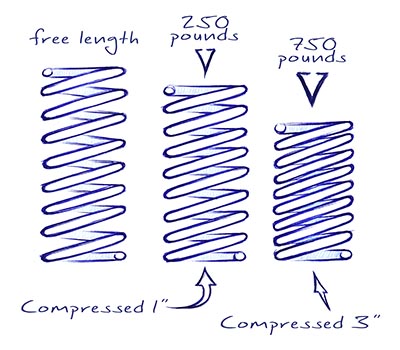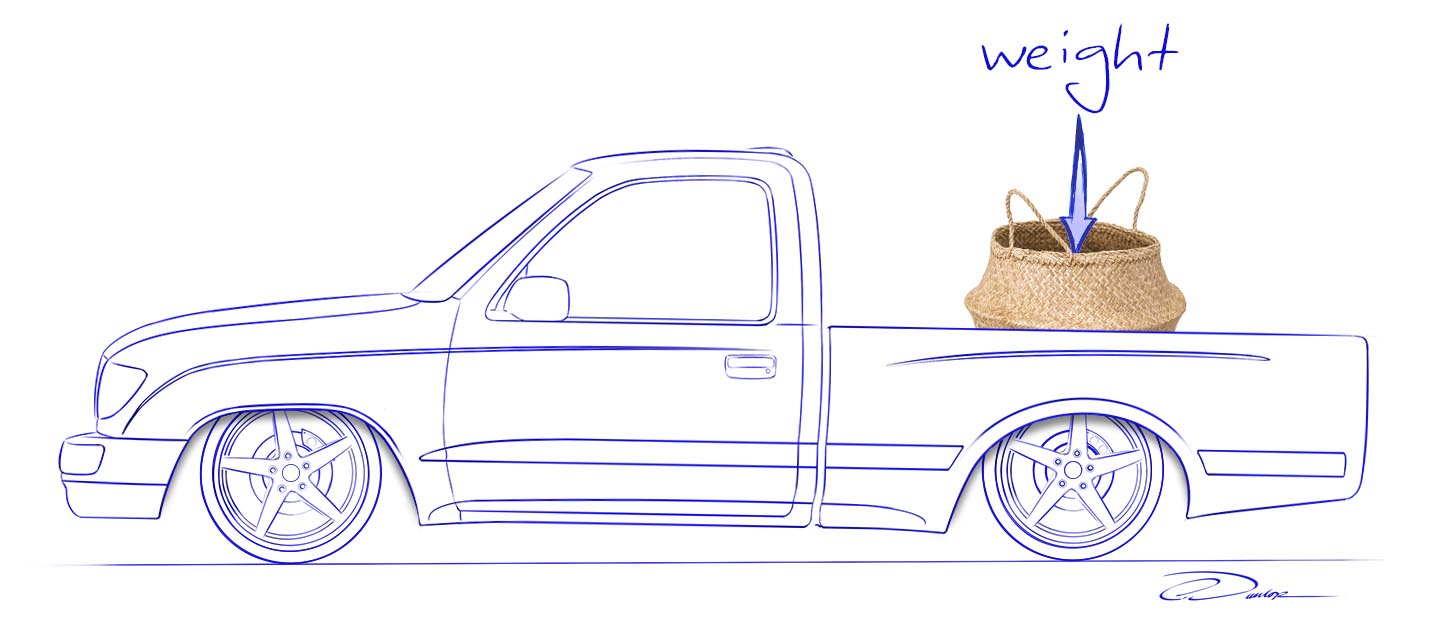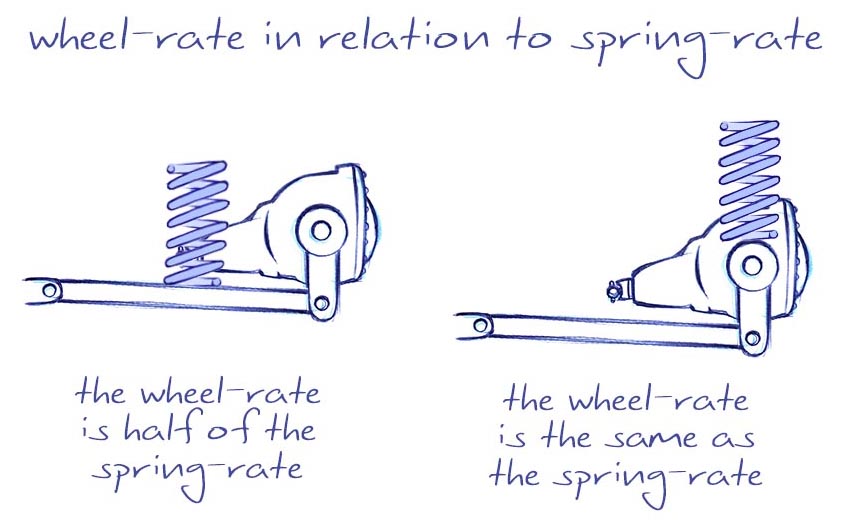
If you found yourself here because you are looking for help with airbags, let me assure you – you are in the right place. However, to keep this as simple as possible, we are going to ignore airbags for a moment and define spring-rate and wheel-rate using traditional steel coil springs. The reason for this is because coil springs are pretty damn consistent when compared to airbags. Coil springs have four primary measurements: physical length, physical diameter, spring-rate, and total travel capacity. And aside from the overall length changing when the spring is compressed, the other measurements don’t really change. We will also assume the coil spring physically fits into our confines and has enough travel capacity for our needs, so those other physical dimensions don’t matter here anyway – the only thing we will concern ourselves with is the spring-rate itself.
**I should note that progressive coil springs do exist, but we are keeping this simple and assuming the spring-rate of any steel spring we talk about here is linear.**
With that out of the way, spring-rate is simply the amount of weight it takes to compress a spring a specific distance. For example, in the US, spring-rate is almost always measured by how many pounds it takes to compress a spring one inch.
Note: pounds and inches are Imperial measurements, so this is not how metric countries would measure their spring-rate. However, the weight/distance concept is still the same.
What this means is if we have a spring with an unknown spring-rate, apply 150lbs of weight to the spring, and it compresses that spring by one inch, then that spring would be considered a “150lb spring” or a “150-rate” spring (for this article, I am going to use the “rate” descriptor to avoid confusing springs and weights). Similarly, a 250-rate spring would take 250lbs to compress the spring one inch, and a 500-rate spring would take 500lbs to compress the spring one inch.

Starting with a 250-rate spring, it will take 250lbs to compress the spring one-inch, but since our spring is linear, every additional 250lbs we add to the spring will compress the spring one additional inch. This means that applying 750lbs to our 250-rate spring will compress the spring a total of three inches.
“What if our springs are installed on a link bar? Will the spring-rate change because it’s under leverage?”
Absolutely!
Well, sort of…
The spring-rate of the spring itself stays the same, of course, but once a spring is installed into a suspension system, the amount of weight it takes to lower the vehicle one-inch would be called wheel-rate. Wheel-rate is what we really care about when it comes to tuning how the vehicle will ride and how firm or soft the suspension is, because how the spring is installed plays a huge role in how the suspension is affected.
Once again, before we move forward, let’s simplify things a bit…
Obviously, most cars and trucks have four wheels, which also means four springs, so let’s use the rear suspension of a pickup truck that just so happens to have a basket in the bed that is centered directly over the axle. That way, any weight we add to the basket only affects the rear suspension.

Again, I should note: a truck is going to have two springs under it, so for this example, we are going to pretend there is only one spring.
If the springs on our simple truck were installed directly on top of the axle, then the wheel-rate would be the same as the spring-rate because one inch of suspension travel translates to one inch of spring travel. However, if the springs were installed directly in the center of a link bar, for example, the springs would compress only a half-inch for every one inch of suspension travel. In our imaginary simple world, this means the wheel-rate will be half of the spring-rate.

*switching back to the airbag conversation*
We ignored airbags during the spring-rate and wheel-rate discussion because nailing down the spring-rate of an airbag is insanely difficult, which also means that finding an exact wheel-rate is going to be equally difficult, if not worse. The reason for this is because airbags are primarily made of rubber, and rubber’s physical properties change pretty wildly based on multiple environmental and manufacturing variables.
Now don’t let this discourage you; just because airbag specs are difficult to nail down doesn’t mean that spring-rate is something we should ignore when setting up your suspension. What it does mean is that trying to hit a specific wheel-rate target using an airbag is not for us mere mortals. But to be honest, most steel springs don’t hit their advertised spring-rate either (they are actually worse than you’d think). Despite that, understanding what spring-rate is and how it works is still very useful for tuning your vehicle’s ride quality.
For anyone who might scoff at this, thinking that spring-rates are easy – understand that I built a load cell system, specifically for documenting airbag spring-rates, and it ended up being WAY more involved than I ever expected. I will eventually post some of my findings, but for now, let’s pretend bags aren’t that complicated and focus on the basics…
The last thing we are going to discuss is force-load – which is super simple but oddly weird to process in your brain sometimes.
Force-load is simply the amount of weight an airbag will support in a static (non-moving) environment.
Before we move forward, though, let me take a moment to clarify that the common descriptor of “I have a 2600# bag” does not accurately describe force-load. It might be how the term started, but it’s by no stretch a universally accurate measurement (or even a useful piece of information, to be honest). Unless you are talking about a specific manufacturer’s part number, the # descriptor is very vague and tells you nothing about the bag besides its general diameter.
*steps down from soapbox*
I think the easiest way to explain force-load would be to use the analogy of you as a human, standing on a standard bathroom scale. In this analogy, “force” is your weight (which would be compared to the weight of the vehicle) and “load” is the weight your scale (the bag) is supporting. Understand that regardless if the scale works or not, it is still supporting your weight. Furthermore, if you are standing on the scale and squat down, then give the scale a moment to settle, the scale will still read the same weight as when you are standing up.
The confusion starts when you look up an airbag’s specs and you see that it has a force-load capacity of say 1800lbs at 100psi. Meanwhile, when installed into a suspension system, the force-load measurement the airbag will produce is simply whatever amount of weight it takes to lift the vehicle off the ground. In the same way that standing or squatting on a scale won’t change how much “load” the scale sees, airing the suspension up or down by adding/subtracting pressure from the bag won’t change the force-load the bag is producing, because the bag is still only supporting the weight of the vehicle.
Unfortunately, things start to get a lot more complicated from here, which is where I will play the “buy my book if you want to learn more” game. However, for the general purpose of learning more about bags, this is what I hope you got from this article:
Spring-rate: the amount of weight it takes to compress a spring one inch
Wheel-rate: the amount of weight it takes to compress the suspension one inch
Force-load: the amount of static weight the bag is supporting

Max Fish is the author of the Air Suspension Design book and has been the owner/operator of the custom fabrication shop Bio Kustumz since 1997. His specialty is developing viable suspension designs for vehicles with unique or challenging confines. He also believes that focusing on a premium driver experience is a critical part of the design process.
Max Fish – personal Facebook and personal Instagram
Air Suspension Book – Facebook and Instagram
Bio Kustumz – Instagram

